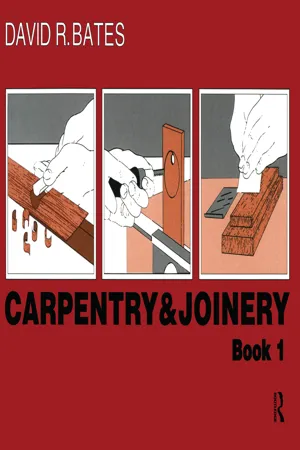![]()
1. Hand Tools and Equipment
After completing this chapter the student should be able to:
1. Name, describe and state the use of the woodworker's marking, measuring and testing tools.
2. Name, describe arid state the function of the various tvoes of saw used bv the woodworker.
3. Name, describe and state the function of the various types of chisel used by the wood-workei.
4. Name, describe and state the function of the various types of plane used by the woodworker.
5. Describe the sharpening procedures for planes, chisels, scrapers and gouges.
6. Select the most suitable type of "brace bit" for a particular job.
7. Sketch and describe the use of the bench hook, mitre box, shooting board, straight edge, winding strips, sawing stool, G cramps and sash cramps.
The Woodworker’s Tool Kit
There can be little doubt that a great deal of skill and expertise is required by any person who wishes to produce good quality items of woodwork. This is true, whether the job in hand be a piece of furniture, an article of joinery, the cutting and erection of a roof or the construction of formwork for a large concrete structure. Whatever type of work is involved, the quality of the finished product depends ultimately upon the ability of the craftsman to cut and shape his material quickly and accurately, either by hand or machine. It is also true to say that the ability of the skilled craftsman to do this depends to a very great extent upon the efficiency of the tools he uses. Even a highly skilled craftsman would have difficulty in producing good work using inferior or badly maintained tools; to the less skilled — the beginner, the apprentice or the trainee — such tools would present wellnigh insuperable difficulties. In truth, the woodworker's job is demanding and difficult enough without the handicap of poor tools and equipment.
In this respect, the student craftsman is urged most strongly to purchase only the finest quality tools available, to keep them sharp and in good order, and generally to look after them and see that they come to no harm in the often arduous conditions under which they may be used.
In short, the craftsman's tool kit is his means of earning a living, and, perhaps equally important, his prime means of obtaining job satisfaction in his chosen career, and it should therefore be treated accordingly.
Tools for Marking, Measuring and Testing
Rules
These are available in various forms such as bar rules, folding rules and flexible tapes. The type most convenient in use depends to a large extent upon the sort of work on which the craftsman is mainly engaged.
Generally speaking, the folding rule or tape will be found most useful for work on site where the rule is carried around in the pocket, and the bar rule most useful in the workshop where extra length and rigidity are no encumbrance.
Bar and folding rules
These are made of steel, boxwood and plastic. The steel rule lends itself better to fine, accurate work, and serves also as a straight edge.
Flexible tapes
These are available up to 30 m in length and are extremely useful for large scale setting out of rooms, buildings, partitions, etc., and for measuring long lengths of timber. Flexible pocket rules up to 3 m in length are always useful for board and sheet measure both on site and in the workshop.
The various types of rule described are shown in Fig. 1.1.
Metric and Imperial units
Rules are available graduated in either metric or Imperial units, i.e. marked in metres/millimetres or feet/inches. Some rules are marked in both, but whilst this may be useful on occasions, they suffer the severe drawback of not having an overall length representing both metric and Imperial units. Where both types of unit are in use, separate rules are generally more satisfactory.
Where choice of rule is concerned, the
Fig. 1.2. Avoiding parallax.
best advice that can be given is to ensure that the rule is well made, clearly marked, and as long as can be conveniently used in the practical situations previously mentioned. Having purchased a rule, use it exclusively, as far as possible, in order to gain familiarity and confidence. It is not good policy to borrow, or to use an unfamiliar rule, especially where the overall unit length differs from one's own, as this is undoubtedly one of the easiest ways of falling into error. Figure 1.2 shows how to use a rule on edge, in order to avoid errors due to parallax, whilst Fig. 1.3 shows how to divide a board into a number of parts by the proportionate method.
Fig. 1.3. Dividing a board into equal parts.
Fig. 1.4. Types of woodworker's try square.
Squares and bevels
Try squares
These are used to mark and test angles of 90° (right angles) and therefore need to be both well made and accurate. They should be well looked after and handled with care in order to retain their accuracy.
Try squares may be obtained made entirely of steel or with a steel blade riveted into a beech or rosewood stock, with brass facings to reduce wear. There is little to choose between the two types, the choice being mainly a matter of personal preference. The size of a try square is denoted by the length of the blade, i.e. the maximum length of a lin...







